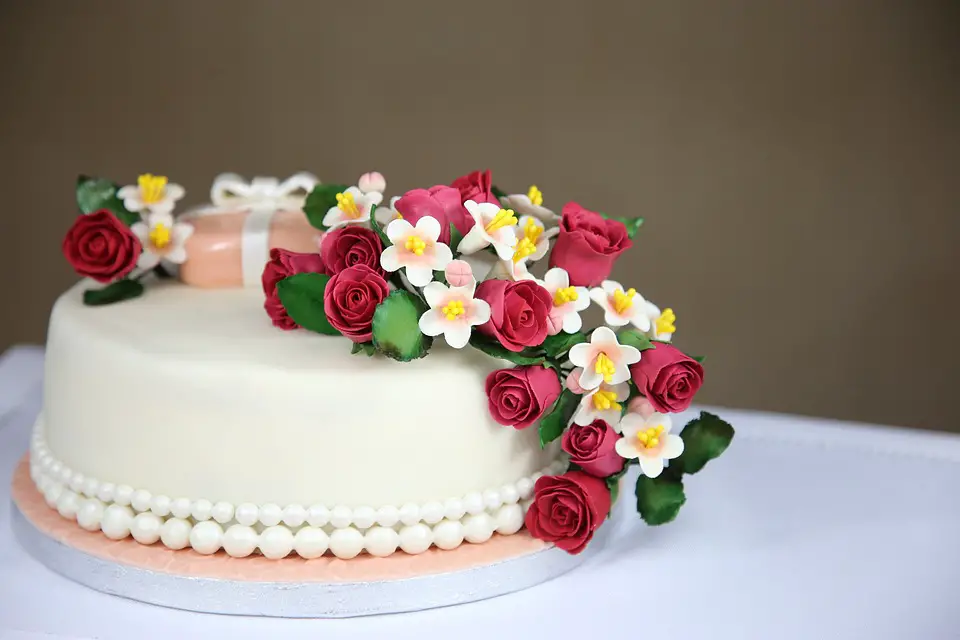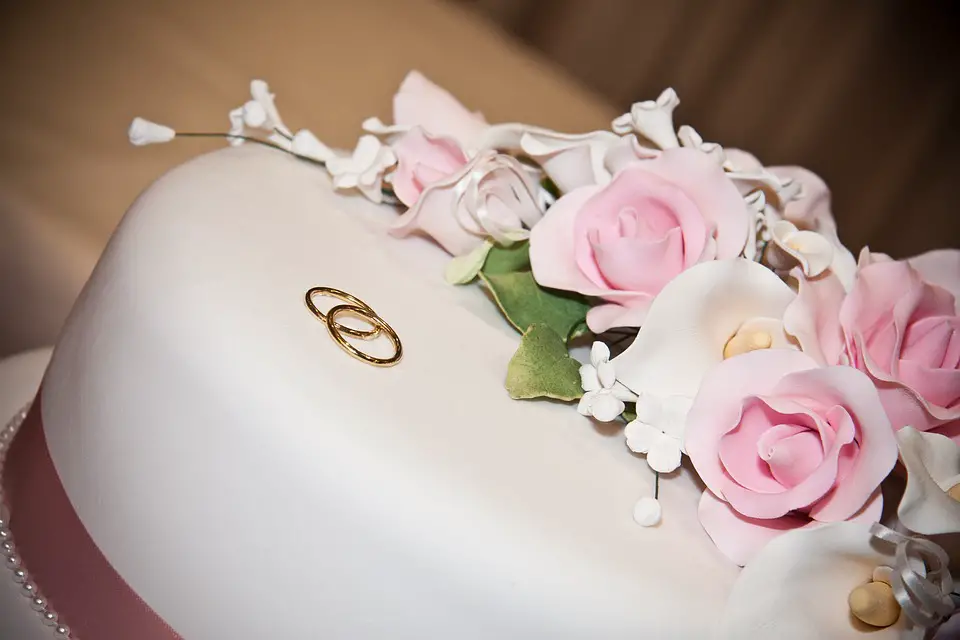Fondant, an edible coating gives the cake a smooth, glossy appearance. It is cooked until it forms a plastic sheet and contains a sugar basis. Although fondant is frequently a crucial component of cake design, it can be tricky to work with because it needs precise temperatures to maintain its beauty after application. The fondant cake may lose shape if the temperature is too warm during storage. If you can’t use the fondant cake right away, you can freeze it, but you must keep it properly, or it will take on too much moisture and turn runny.

How to Freeze Cake with Fondant Icing?
Wait for your fondant-covered cake to reach room temperature entirely. To ensure no air between the cake and the plastic wrap, tightly wrap the entire cake and push it down.
Another layer of the plastic wrap should be tightly placed over the cake. To completely protect the fondant from condensation from the freezer, repeat the plastic-wrapping procedure at least once more.
To help stop flavors or odors from the freezer or storage container from transferring into the cake, wrap a layer of aluminum foil tightly around the plastic layers. Put the cake in a cardboard cake box and secure the lid.
To ensure the cardboard cake box stays frozen, put it in the back of the freezer. Defrost the cake after no more than two months in the freezer.
The cake box should be completely removed from the freezer and left to thaw at room temperature in its packaging. Serve after gently removing the plastic wrap and aluminum foil to prevent condensation from dripping over the cake.
What is the Correct Method of Storing Fondant Cake?
In the Fridge
The main reason fondant cakes sweat in the refrigerator is the high humidity, which instantly condenses the fondant. A fondant cake must be properly wrapped or boxed before being placed in the refrigerator to prevent the fondant from coming into contact with the refrigerator’s dampness. Before you unwrap the fondant cake after taking it out of the fridge, it must gradually warm up to room temperature. Make sure you account for the hour I typically allot for this.
In Freezer
Yes, fondant cakes can be kept in the freezer, even if adorned. The same guidelines as before are relevant. As soon as the cake is properly wrapped or boxed, let it gently come to room temperature. Even if the fondant cake is wrapped, removing it from the freezer and bringing it to room temperature will be a significant change due to the freezer’s low temperatures. Therefore, if you freeze your fondant cake, move it to the refrigerator the night before. The following day, bring it to room temperature.
What is the Shelf Life of Fondant Cake?
In the Fridge
Some cakes and pastries need to be refrigerated based on the ingredients used. For instance, it’s crucial to store fresh fruit in a colder setting rather than at room temperature if it’s included in the dish.
In light of this, you can preserve your fondant-covered dessert in the fridge for up to 3 days if keeping it at room temperature is not an option. But be careful—moisture is almost tough to keep out of your meal. Please do your best to keep the items within a corrugated cardboard container and cover them with plastic wrapping.
Because of their three-layer thick lining and hygienic qualities, corrugated cardboard containers perform better than standard cardboard containers. Tape the plastic wrapping as firmly as possible to the container for additional sealing.
Within the Freezer
Due to its high sugar content, fondant does not require freezing as most perishable products. Most of the foods in our cupboard must be eaten immediately or frozen for later use. The longer shelf life of our products is due to freezing, which slows down the growth of microorganisms.
However, store-bought fondant has a shelf life of one to two years. Even homemade fondant doesn’t need to be frozen and can keep for up to two months. Not to mention the harm moisture, when the fondant thaws, will cause. Condensation will be produced during thawing, a natural adversary of fondant because it will lose its shaping capacity.
Keep your fondant at room temperature to conserve that limited space in your overstuffed freezer.
How to Thaw a Whole Cake with Fondant Icing?
Consume the cake in a year. You can still eat your wedding cake on your first anniversary if you’re saving it. After that, though, you really shouldn’t eat it too often. There will undoubtedly be a decline in flavor and quality.
If it’s not a wedding cake, attempt to consume your cake within six months or less for the finest quality.
For at least 24 hours, place the covered cake in the refrigerator. In the refrigerator, begin the thawing procedure. Keep the cake wrapped up because removing it at this time could cause damage.
Before eating, you can store it in the refrigerator for up to two days. After that, it can start to become stale.
Place the entire cake on the work surface. Take it out of the refrigerator an hour or so before you want to eat it once it has thawed. This will hasten the temperature rise to an appropriate level for eating.
While it thaws on the counter, keep it wrapped up.
To enjoy the cake, remove the packaging. Your cake should have numerous layers of wrappings if you prepared it properly. Use caution while removing any plastic wrap or aluminum foil you may have used because it might have adhered to the cake in some spots.
If the cake’s outside is unfrosted, you can do it now while it thaws.
Don’t forget to decorate the cake. Using the cake as a party or table centerpiece, use a knife to even out the frosting. Since there shouldn’t have been any decorations on the cake when you froze it, add any additional ones.
If you freeze it, the decorations on the cake are probably squashed. Damage control measures like scraping off frozen decorations can be necessary. To cover up the damage, spread the icing evenly and add sprinkles or garnish.
Sprinkles and other decorations might bleed. In that instance, you might be able to create a creative look by sprinkling the colors into the cake frosting.
What are Different Kinds of Fondant?
Most bakers may encounter one of two main varieties of fondant. Either homemade or store-bought, this is. The fondant may be “rolled,” which has a dough-like consistency and produces a smooth, frosted, and satiny surface.
The term “quick-pour” fondant refers to a different kind of fondant. This kind of fondant is frequently extremely sweet, sparkly, and colorful. Thus it is nearly never purchased from a store and is almost always created at home. This type of fondant should be used right away.
When designing a cake, you should consider both types of fondant because they each have unique qualities to offer. One fondant is more textured, allowing you to cut, mold, and shape it into cake embellishments.
The other kind of fondant is like a liquid that dries into a lovely fondant, so you can only use it to cover a cake rather than decorate it.
How to Tell if your Fondant Cake has Gone Bad?
There are a few glaring signs that the fondant has gone bad. Look out for these indications:
Texture
It’s a positive indicator if the fondant seems to be soft and can be easily worked. If it is rigid or crumbling, though, it’s time for some fresh fondant.
Brightly colored fondant icing fades soon. If the coloring seems vibrant and there are no other signs of deterioration, you should only utilize the fondant.
Smell
You should avoid using fondant if it is overtly offensive or smells funny. If you notice that food smells bad, do not taste it.
Taste
With the aid of taste, you can determine whether the fondant is still suitable for usage fast. However, avoid tasting something if it is inappropriate based on its appearance.
Mold
A dense sweet is a fondant. You discard the fondant if it has mold on it. On the other hand, there is a good chance that mold will penetrate the fondant. You must thus handle it carefully and give it a close inspection.
What are the Side Effects of Consuming Cake with Fondant Icing?
Desserts can cause you to gain weight because they are highly high in fat and carbohydrates.
Cake sugars can raise blood glucose levels, which increases the risk of long-term diabetes.
Cakes that contain chocolate and almonds are high in serotonin, which can thrill and cheer you up. Cake has a negative psychological effect since it externally stimulates serotonin.
Cakes made with margarine, or butter may cause blood cholesterol levels to rise.
Psychoactive marijuana (cannabis) in baked goods might have adverse effects such as elevating mood, anxiety, enthusiasm, etc.
The dyes used to color velvet cupcakes can upset your stomach; some may even be allergic to them.
Calorie in Cake
The cake contains a significant amount of calories compared to other baked goods. A huge 352 calories are contained in a slice of chocolate cake measuring one-twelfth of a 9-inch diameter without frosting. That might easily account for 20% or more of your daily calorie allowance, especially if you’re trying to lose weight. One-twelfth of an angel food cake with a 10-inch diameter has 128 calories, compared to 264 for a slice of white cake of the same size. If you add two tablespoons of frosting, you’ll add 163 calories for chocolate and 100 calories for cream cheese. By removing the majority of the frosting and eating fewer servings, you can reduce the calories you consume.
Content of Fat
The cake contains many calories from fat, which has nine calories per gram. White cake has just over 9 grams of fat per slice, whereas angel food cake has only 0.15 grams. A slice of chocolate cake has slightly more than 14 grams of fat. Cream cheese frosting comprises roughly 4 grams of fat per two tablespoons, compared to about 7 grams in two teaspoons of chocolate frosting. No more than 20 to 35 percent of your daily calories should be fat. On days when you have cake, choosing low-fat foods for your meals will assist you in avoiding consuming too much fat.
Reference: Development and characterization of green banana-based fondant icing
The objective of the current study was to create and describe the physical, physicochemical, microbiological, and sensory characteristics of fondant icings made from flour and green banana biomass. Two formulations were created and compared to the commercial fondant icings: NFBI (Neutral Flavor Biomass-based Icing) and CFBI (Chocolate Flavor Biomass-based Icing) (NFCI – Neutral Flavor Commercial Icing, and CFCI – Chocolate Flavor Commercial Icing). The centesimal composition, caloric value, physical and physicochemical (resistant starch, titratable acidity, water activity, texture, and color), microbiological, and sensory qualities of the fondant icings were all assessed.
Conclusion
Whenever you have a cake that needs to be frozen, you will want to freeze it in an airtight container. You can use either buttercream frosting or fondant icing. But be aware that the longer you freeze a cake, the drier it becomes. First, you will want to make sure your cake is well-filled. Filling the cake evenly will help it hold the fondant icing in place. Then, wrap the cake tightly with plastic wrap. Do this again until the entire cake is covered in plastic.
Next, you will want to ensure you store your fondant icing in a cool, dry place. This helps maintain the consistency and flavor of the icing. It is also helpful to store it in an airtight container.

